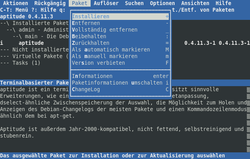Aptitude
| Aptitude
|
|
|---|---|
 Screenshot from Aptitude |
|
| Basic data
|
|
| developer | Daniel Burrows |
| Publishing year | 1999 |
| Current version |
0.8.12-1 ( August 25, 2019 ) |
| operating system | Linux , Unix |
| programming language | C ++ |
| category | Package management |
| License | GPL ( Free Software ) |
| German speaking | Yes |
| wiki.debian.org/Aptitude | |
Aptitude is a front end for the Advanced Packaging Tool (APT). The program displays a list of software packages and allows the user to interactively manage packages. It was originally created for the Debian distribution, but apart from its many variants, it was also used in RPM- based distributions.
Aptitude is characterized by a character-oriented user interface based on ncurses , which, compared to the pure command line tool apt-get, allows a somewhat more comfortable interaction with APT.
Like apt-get, aptitude has an additional integrity layer in which package states are stored. There the software registers which packages are automatically installed as a result of dependencies and is thus able to automatically suggest packages that are no longer required (orphaned) for deinstallation. Furthermore, Aptitude keeps its own log, independent of APT, over the entire installation history and possible conflicts.
history
The development of Aptitude started in 1999 . At that time, two other console-based APT front ends were available: the dselect program, which was used to install Debian before APT existed, and console-apt, a project that was classified as the direct successor to dselect. The aptitude project was originally started to experiment with a more object-oriented design than console-apt . The goal was a more flexible program with a wider range of functions.
The first version 0.0.1, published on November 18, 1999, was still very limited in its functionality: A list of the available packages could be displayed, but neither downloading nor installing was possible. With the version 0.0.4a contained in Debian 2.2 ( code name Potato), these features were added.
Towards the end of 2000 the entire interface module was rewritten; the new architecture is based on the callback library libsigc ++ and concepts of modern GUI toolkits such as GTK + and Qt . This made it possible to design the interface with functions such as drop-down menus and pop-up dialogs to be more GUI- like than before. The first official Aptitude release was 0.2.0. Aptitude 0.2.11.1 was released together with Debian 3.0 (code name Woody ). At that time, console-apt was abandoned by its developers and removed from the repository .
Since Debian 3.1 (codename sarge ) is the preferred Aptitude console-based installation method, replacing the former for reasons of backward compatibility maintained dselect .
Web links
Individual evidence
- ↑ salsa.debian.org . (accessed on September 6, 2019).
- ^ The aptitude Open Source Project on Open Hub: Languages Page . In: Open Hub . (accessed October 30, 2018).
- ↑ What is this aptitude thing, anyway? ( Memento of the original from August 26, 2017 in the Internet Archive ) Info: The archive link was automatically inserted and not yet checked. Please check the original and archive link according to the instructions and then remove this notice. , Aptitude manual; Retrieved August 25, 2017